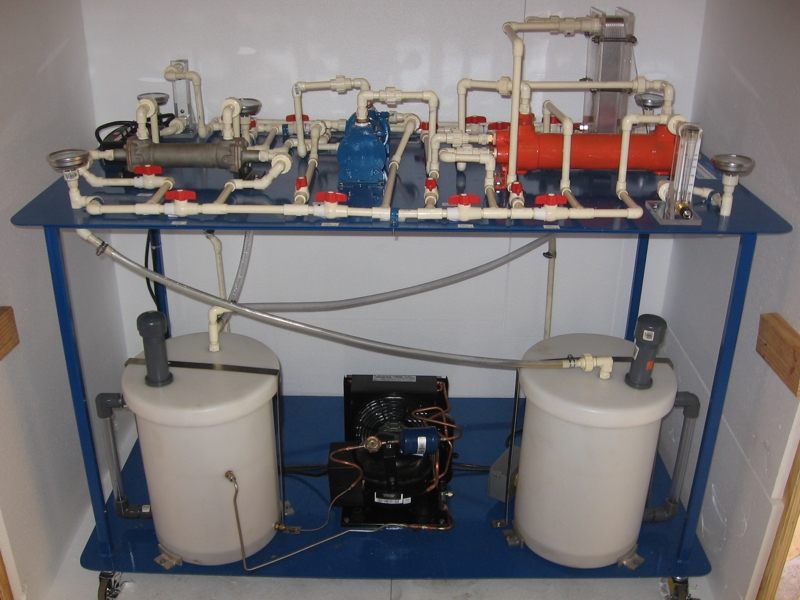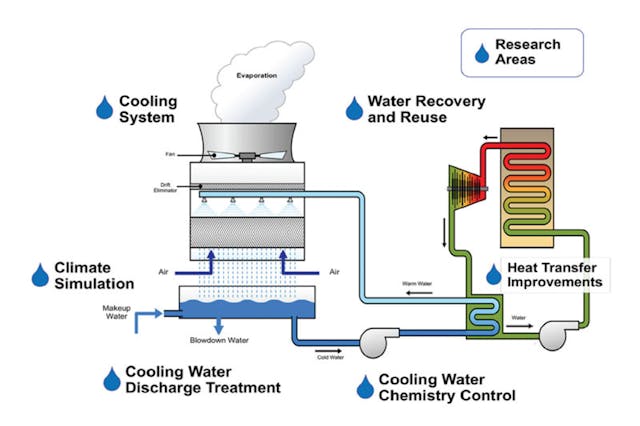The Duty of Heat Transfer Solutions in Sustainable Power Solutions for the Future
Heat transfer systems are crucial in the mission for sustainable energy services. They maximize thermal energy monitoring, enhancing the efficiency of renewable innovations. By using mechanisms like conduction, convection, and radiation, these systems decrease energy losses. Their duty in solar thermal and geothermal applications is specifically substantial. As innovations emerge, the capacity for additional advancements raises vital concerns regarding future power approaches. What growths will form the landscape of lasting power?
Understanding Heat Transfer Systems

The Relevance of Thermal Power Administration
Effective thermal power monitoring is crucial for making the most of power performance and lessening waste in various systems. By regulating temperature and maximizing Heat transfer processes, companies can markedly lower power usage and operational prices. Efficient administration involves the implementation of advanced modern technologies and methods that monitor and manage thermal problems within systems, guaranteeing that energy sources are utilized successfully. Furthermore, proper thermal energy administration contributes to lowering greenhouse gas discharges, aligning with worldwide sustainability goals. It also improves system integrity and performance, bring about improved item high quality and longer tools life expectancy. Eventually, focusing on thermal power management is a crucial step towards developing extra sustainable power solutions and promoting a liable method to power intake in industrial and property contexts.
Applications of Heat Transfer in Renewable Resource
While various renewable resource sources guarantee sustainability, the reliable application of Heat transfer plays a vital role in their performance. In wind energy systems, Heat transfer is used for generator component cooling, improving efficiency and longevity. Geothermal energy relies upon efficient Heat exchange between the planet's subsurface and the liquid distributing in the system, optimizing power extraction. Biomass energy processes likewise profit from Heat transfer, as it aids in converting organic materials into functional gas via pyrolysis and gasification. In addition, in hydropower, maintaining ideal temperatures in tanks can enhance energy outcome. Each of these applications demonstrates the crucial value of Heat transfer systems in improving renewable resource technologies, inevitably adding to a more lasting power future.
Enhancing Solar Thermal Power Performance
As solar thermal power systems proceed to advance, boosting their efficiency has actually ended up being necessary for making best use of power outcome. Developments in Heat transfer technologies, such as boosted thermal storage space materials and innovative Heat exchangers, play a substantial duty in improving efficiency. By utilizing advanced products that have remarkable thermal conductivity, systems can move and catch Heat extra properly. Furthermore, integrating radar that adhere to the sun's course warranties that collection agencies receive excellent solar direct exposure throughout the day. Using nanotechnology in solar absorbers can even more increase power absorption rates. Incorporating automated control systems aids handle and regulate temperature levels energy circulation efficiently, leading to lowered losses and improved general system performance. These enhancements pave the method for even more sustainable solar thermal power remedies in the future.
Geothermal Heating: A Lasting Remedy
Geothermal heating offers a practical alternative for lasting energy, using substantial ecological advantages through decreased greenhouse gas exhausts. Its efficiency and cost-effectiveness make it an appealing choice to standard heating systems. Obstacles connected to implementation must be addressed to maximize its possible effect.
Ecological Benefits of Geothermal
Conventional heating approaches add significantly to greenhouse gas discharges, geothermal heating provides a compelling alternative that minimizes ecological influence. By using the Planet's interior Heat, geothermal systems use a renewable resource resource, considerably reducing dependence on nonrenewable fuel sources. This approach produces minimal carbon emissions, making it a cleaner alternative for property and commercial home heating. Furthermore, geothermal systems advertise power efficiency, as they call for less power compared to traditional furnace. DVS Heat Transfer Systems. The utilization of geothermal power also aids in minimizing air pollution, improving local air quality and public health. As a lasting option, geothermal home heating supports environment modification reduction efforts, positioning itself as an important component in the shift in the direction of a greener future
Effectiveness and Cost-Effectiveness
Just how does geothermal heating determine up in regards to efficiency and cost-effectiveness contrasted to traditional heater? Geothermal home heating demonstrates premium effectiveness, typically attaining a coefficient of performance (POLICE OFFICER) of 3 to 5, meaning it creates 3 to 5 units of Heat for every single unit of electrical energy consumed. This effectiveness converts right into lower operating expense, specifically in regions with steady geothermal sources. First installation expenses can be higher than conventional systems; nevertheless, long-lasting financial savings on energy bills and minimized upkeep expenditures can offset these in advance financial investments. In addition, many governments incentivize geothermal systems with refunds and tax obligation debts, enhancing their cost-effectiveness. In general, geothermal home heating becomes a lasting and financially sensible alternative to more conventional heating solutions.
Implementation Challenges and Solutions
Various difficulties can hamper the prevalent execution of geothermal heater, in spite of their clear benefits as a sustainable power remedy. High first installment expenses commonly hinder property owners and financiers, making financing a significant obstacle. In addition, the geographical constraints of appropriate geothermal sites limit accessibility in particular areas. Regional regulations and allowing procedures can likewise make complex project development, leading to hold-ups. Public recognition and understanding of geothermal systems stay low, preventing acceptance. To deal with these challenges, targeted education and learning projects can enhance open secret, while federal government incentives can reduce financial worries. Working together with local authorities to enhance policies may assist in smoother project authorizations, ultimately advertising the adoption of geothermal home heating as a practical, lasting energy option.
Technologies in Heat Transfer Technologies
Technologies in Heat transfer modern technologies play an important role in boosting energy efficiency and sustainability. Advanced Heat exchangers and stage modification products are at the leading edge of these developments, using considerable enhancements in thermal monitoring. These innovations not just maximize energy use yet additionally add to lowering ecological influence in numerous applications.
Advanced Heat Exchangers
Advanced Heat exchangers play a crucial function in boosting power efficiency across various applications in sustainable energy remedies. These tools promote the transfer of Heat in between 2 or more liquids, noticeably reducing power usage in procedures such as industrial home heating, cooling, and power generation. Technologies in products and design, such as the use of nanofluids and small configurations, have actually led to boosted thermal performance and minimized size demands. Additionally, developments in digital tracking and control systems enable enhanced operation, additional DVS Heat Transfer Systems boosting performance. By decreasing waste Heat and optimizing power healing, progressed Heat exchangers add to decrease carbon impacts and sustain the change towards eco friendly innovations. Their continued development is important for achieving global power sustainability objectives.
Stage Adjustment Materials
The assimilation of stage change products (PCMs) right into Heat transfer technologies stands for a considerable improvement in energy management and efficiency. PCMs absorb and release thermal power throughout their stage modifications, allowing efficient temperature level law in structure materials and energy systems. By saving excess Heat during optimal durations and launching it when need boosts, PCMs add to load changing and energy conservation - DVS Heat Transfer Systems. This ability boosts the efficiency of renewable power systems, especially in solar thermal applications. Additionally, PCMs can boost the thermal comfort of indoor settings, lowering dependence on traditional heating and cooling down techniques. As developments in PCM formulations remain to emerge, their duty in sustainable energy solutions is positioned to expand, supplying encouraging methods for future study and application

Future Potential Customers for Heat Transfer in Sustainable Energy
As the need for lasting power remedies proceeds to climb, the function of Heat transfer systems is ending up being increasingly crucial fit future technologies. Developments in materials and styles are expected to enhance effectiveness in Heat transfer, lowering power losses in various applications. The integration of innovative thermal storage space systems, such as phase change products and thermochemical storage space, will make it possible for far better monitoring of power sources. Research right into nanofluids and biomimetic Heat exchangers may additionally optimize thermal efficiency. Moreover, the fostering of smart technologies will permit real-time tracking and adaptive control of Heat transfer processes. These innovations are poised to significantly add to the overall performance and sustainability of power systems, leading the way for an extra energy-efficient future.
Frequently Asked Concerns
Exactly How Can Individuals Carry Out Heat Transfer Systems in the house?

People can implement Heat transfer systems in your home by setting up energy-efficient devices, using radiant heat, and maximizing insulation. These procedures enhance power effectiveness, reduce expenses, and advertise lasting practices in residential atmospheres.

What Are the Expenses Related To Installing Heat Transfer Solutions?
The expenses related to installing Heat transfer systems vary commonly, typically encompassing equipment, installation labor, and upkeep. Factors such as system type, home size, and regional regulations greatly affect the general expenditure included.
Are There Federal Government Rewards for Heat Transfer System Installations?
Government motivations for Heat transfer system setups vary by area and can include tax discounts, credit scores, and grants. These financial advantages intend to motivate adoption, eventually promoting energy efficiency and lowering environmental impact within communities.
How Do Heat Transfer Systems Effect Energy Bills?
Heat transfer systems notably affect power costs by optimizing power performance. By boosting the transfer of Heat, these systems decrease power usage, bring about reduced energy costs and developing a much more lasting strategy to energy administration.
What Maintenance Is Needed for Heat Transfer Equipments?
Maintenance for Heat transfer systems consists of regular assessments, cleansing of components, examining liquid degrees, making certain proper insulation, and replacing used components. These tasks assist maintain effectiveness, prevent malfunctions, and prolong the system's operational life expectancy.
These systems facilitate the activity of thermal power from one medium to an additional, allowing the transfer of Heat for energy, cooling, or heating generation objectives. Geothermal energy relies on effective Heat exchange between the planet's subsurface and the liquid circulating in the system, optimizing energy removal. In addition, geothermal systems advertise power performance, as they call for less energy contrasted to traditional home heating systems. Advanced Heat exchangers play a crucial duty in enhancing power performance across numerous applications in sustainable power options. Heat transfer systems notably influence energy bills by optimizing power efficiency.